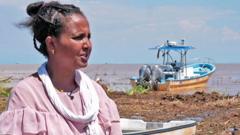As the sun set over Lake Turkana, Senait Mebrehtu mourned the loss of her daughter, Hiyab, who tragically drowned while trying to reach Kenya through a dangerous smuggling route. With tears in her eyes, the Eritrean mother recalled how her teenage daughter, only 14 years old, was among many migrants attempting the risky crossing over the vast lake, where strong winds can easily topple boats.
Senait, a Pentecostal Christian who fled Eritrea three years ago to escape religious persecution, traveled to the site where her daughter’s life was lost. Her journey to revisit the spot was fueled by a sorrow that left her heartbroken. "If the smugglers told me there was such a big and dangerous lake in Kenya, I wouldn't have let my daughters come this far," she lamented.
Having initially arrived in Kenya's capital on a tourist visa with her two younger children, Ms. Senait was forced to leave her older daughters behind due to the risks of conscription in her militarized home country. Desperate to reunite, family members advised her to enlist the help of smugglers to facilitate her daughters' passage. However, this decision placed their lives in the hands of traffickers, whose negligence proved fatal.
One smuggler confirmed to the BBC that Lake Turkana has increasingly become a route for clandestine crossings, now dubbed the "digital route" due to its recent emergence. This female smuggler, who has been part of a notorious human trafficking network for over 15 years, acknowledged the risks migrants face. She earns hefty fees, reportedly around $1,500 per migrant, and expressed her conflicted feelings about the business, cautioning against allowing children to undertake such perilous journeys.
Eyewitness accounts from fellow migrants and locals painted a harrowing picture of Hiyab's final moments. Osman, who was similarly crossing Lake Turkana, recalled watching as Hiyab's boat capsized due to overcrowding—an apparent consequence of traffickers prioritizing profit over safety. Hiyab’s sister was among the few survivors, clinging to debris until another smuggler's vessel came to the rescue.
Tragic incidents have become commonplace on the lake, with fishermen recalling disturbing sightings of bodies believed to belong to migrants, raising urgent concerns about the dangers associated with smuggling practices. The growing number of Eritrean refugees, now reaching 345,000 in East Africa alone, reflects a widespread urge to flee from the oppressive conditions in Eritrea.
Legal experts highlight that the instability in surrounding regions, such as Ethiopia and Sudan, has led to increased migration towards countries like Kenya and Uganda—often viewed as potential safe havens. However, for many, these nations serve merely as transit points in an exhausting journey towards refugee status and safety.
As Senait endures the anguish of losing Hiyab, she remains grateful that her elder daughter successfully escaped the clutches of the very smuggling network that claimed her other child. “We have gone through what every Eritrean family is going through,” she reflected. Her plea resonates for peace and healing within their war-tattered homeland, hoping that others might one day find solace instead of sorrow on shores like those of Lake Turkana.




















